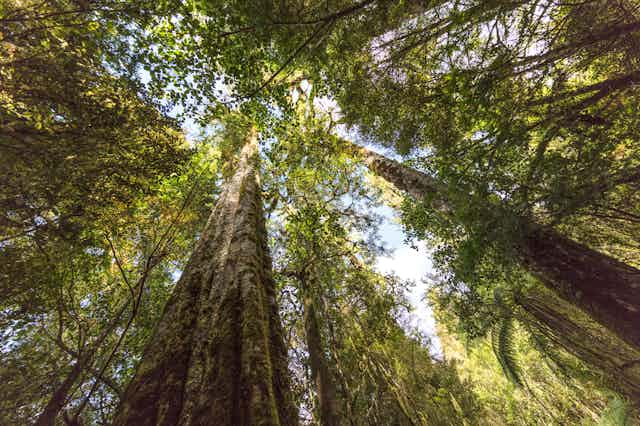New Zealand’s per-capita contribution to carbon emissions is very high by international comparison. But so too is its potential to mitigate climate change by planting forests to quickly sequester large amounts of carbon.
There is sometimes passionate debate about how best to do this. Should we continue establishing radiata pine plantations, or focus instead on planting New Zealand native trees?
Arguments for and against each option exist – but there is also a third way that could achieve the best of both worlds: planting radiata pine forests that are not harvested, but instead transitioned over time into native forests through targeted management.
We need to cut emissions drastically. But we also need to remove as much CO₂ from the atmosphere as possible, especially over the next 20 years. A transitional forest model is a powerful way to help achieve this.
Farming carbon using trees
As trees grow they absorb CO₂ from the atmosphere and lock the carbon into wood, leaves, roots and soil.
The New Zealand Emissions Trading Scheme (ETS) provides income from growing trees to store carbon. It is a key tool for meeting domestic and international climate change targets, including the 2050 target set by the Climate Change Response Act 2002.
A newly planted native forest will absorb approximately 40 tonnes of atmospheric CO₂ per hectare over ten years. By contrast, an exotic radiata pine forest will achieve five to ten times this amount over the same period.
In other words, to absorb a given quantity of carbon during the early stages of reforestation, it will take five to ten times more farmland using natives. Because of this enormous advantage of exotics over natives, there is a place for exotic carbon farming.
Some object to pine planting on purely aesthetic grounds – they just don’t like the look of radiata forests. And we agree there are some places where pine is just not appropriate for the landscape. But the urgency to mitigate climate change means we need to turn as much unprofitable pasture into forest as possible.
Radiata forests are also criticised for being monocultures that lack biodiversity. But the pasture they replace is also a monoculture that contains even less biodiversity. Planting trees on pasture also reduces gross emissions by reducing animal stock and therefore methane emissions.

We can’t plant too many trees
A year of emissions in Aotearoa New Zealand equals 78.8 million tonnes CO₂ equivalent, based on 2020 figures. To offset this for a ten-year period would require planting roughly 20 million hectares of pasture in native trees, then waiting ten years for them to grow.
The total area of Aotearoa is 26.9 million hectares, with 3 million of those being mountains. Therefore, another treeless country of a similar size would be required to fully offset its emissions using native trees alone. Using radiata pine would require 2 to 4 million hectares.
At an individual level, just one return trip from Auckland to London for one person will produce approximately 11 tonnes of CO₂ emissions. To offset this would require planting over a quarter of a hectare (almost an acre) of native trees, and waiting ten years for them to grow.
On current projections, Aotearoa will need to purchase 100 million tonnes of offshore carbon credits to meet its international commitments. According to Treasury calculations, this will cost between NZ$3.3 billion to $23 billion between now and 2030.
Obviously, the country cannot offset all its emissions by planting trees, native or exotic. Reducing emissions in the first place is the priority. But from a climate perspective, we cannot plant too many trees of any kind.
Restoring biodiversity over time
One of the criticisms levelled at exotic carbon forests is that the carbon storage is not permanent because of the shorter lifespan of pine. But pine plantations in New Zealand can keep accumulating carbon for at least a century if they’re not harvested.
Also, the carbon storage is permanent if exotic forests are transitioned into self-sustaining native forests. This process occurs naturally, but can and should be accelerated by targeted management.
Because radiata pine needs a lot of light to grow, its own seedlings will not establish beneath its canopy. Therefore, pine will naturally decline over time and gradually be replaced by native forest, a process that occurs naturally but takes many decades.
To provide crucial structural and species diversity, and to expedite the transition process, native trees requiring plenty of light need to be planted, and pine trees need to be thinned. This is nothing like commercial harvesting, so the problems associated with forestry “slash” do not arise.
Fruiting natives will attract birds and enhance seed dispersal. At the same time, the income from carbon credits through the ETS can be used for further plantings, and also to fund intensive animal pest control – a critical step towards rebuilding native forests.
Eventually, this strategy will provide both permanent carbon storage and carbon capture that continue way beyond a century. But within decades we would also see the return of large areas of highly biodiverse native forests.

